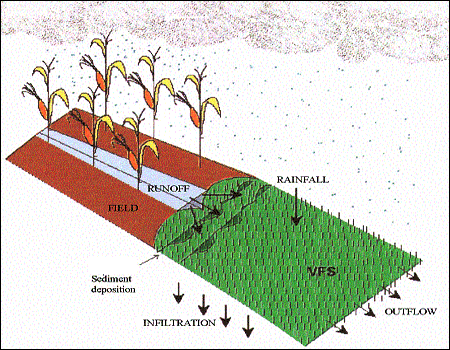VFSMOD: Vegetative Filter Strip Modeling System
In memory of John E. Parsons (1952-2005) - our mentor and friend.
VFSMOD video overview
Professor Rafael Muñoz-Carpena from the University of Florida presents in this video the mechanistic concepts behind predicting pesticide runoff reduction using vegetation buffers or vegetative filter strips (VFS), and how the numerical model VFSMOD was developed, tested and applied in the pesticide registration regulatory process for quantitative mitigation of pesticides with VFS. This video was recorded for a seminar presented to Clemson University under the direction of Prof. Christophe Darnault.
Abstract
Vegetative Filter Strip Modeling System (VFSMOD) is a design-oriented vegetative filter strip modeling system. The MS-Windows VFSMOD-W graphical user interface (GUI) integrates the numerical model VFSMOD, a utility to generate source (upslope disturbed area) inputs for the model based on readily available NRCS site characteristics (UH), and advanced uncertainty and sensitivity analysis, inverse calibration and design menu-driven components.

VFSMOD, the core of the modeling system, is a computer simulation model created to study hydrology, sediment and pollutant transport through vegetative filter strips (VFS). The model comprises the following modules:
- Finite element solution for the overland flow equations.
- Green-Ampt infiltration method for unsteady rainfall.
- University of Kentucky grass sediment deposition and filtration.
- Contaminant transport component (first implemented for pesticide reduction within the risk massessment and management regulatory process).
The advantage of VFSMOD over other models used to simulate VFS pollution removal is the inclusion state of the art description filter hydrology including changes in flow derived from sediment deposition, physically based time dependent soil water infiltration, handling of complex storm pattern and intensity and varying surface conditions (slope and vegetation) along the filter. This model formulation effectively handles complex sets of inputs similar to those found in natural events. The model is targeted at studying VFS performance on an event-by-event basis and when combined with the upslope source area input preparation utility (UH or others like PRZM), becomes a powerful and objective VFS design tool. The design paradigm implemented in VFSMOD seeks to identify optimal filter constructive characteristics (length, slope, vegetation) to reduce (to a prescribed reduction target like a TMDL) the outflow of pollutants from a given disturbed area (soil, crop, area, management practices, design storm return period). Additionally, the program provides three powerful tools. The sensitivity analysis allows the user to identify important parameters for a given model application and simplify model calibration. An automated inverse calibration algorithm serves to identify effective model parameters when measured field data is available. Finally, after the filter design exercise, uncertainty analysis can be conducted to identify the level of confidence that the adopted design has based on propagating the input uncertainties onto the model outputs.
VFSMOD has been tested in a wide variety of settings (agroforestry, mining and roads) with good model predictions against measured values of infiltration, outflow, and vegetation trapping efficiency for sediments, phosphorus (particulate and dissolved), and pesticides. Although the model was originally developed as research tool, is now widely used by consultants, planners and regulators to design optimal filter strips for specific scenarios or to assess effectiveness of existing VFS.
Documentation for the model is available in several forms (web, printable PDF and online program help). This version of the model uses inputs that are easily obtainable from tables and other sources contained in the manual.
Disclaimer
Vegetative Filter Strip Modeling System (VFSMOD) was developed in the Department of Biological and Agricultural Engineering, North Carolina State University USA, by Dr. Rafael Muñoz-Carpena under the direction of Dr. John E. Parsons. The model is now maintained by Dr. Muñoz-Carpena at the Agricultural and Biological Engineering of the University of Florida (USA).
The model and associated documentation is supplied as-is with no warranty - explicit or implied. As with any model, the results are totally dependent on the user's ability to wisely select input parameters that represent the "field" and to interpret the results.
We will make every effort to provide assistance and encouragement as our other commitments allow. We do ask that you reference our work if you find it helpful in your pursuits.
Free licencing
VFSMOD by Rafael Muñoz-Carpena is licensed under CC BY-ND 4.0
The model is provided to you as an educational, research and application tool under the terms of the Creative Commons license, CC BY-ND 4.0 (Creative Commons Attribution-NoDerivatives 4.0 International). This license requires that reusers give credit to the creator. It allows reusers to copy and distribute the material in any medium or format in unadapted form only, even for commercial purposes.
Rafael Muñoz-Carpena
Agricultural and Biological Engineering | University of Florida | Gainesville, FL 32611
John E. Parsons (deceased October 2005)
Biological & Agricultural Engineering | Box 7625 | North Carolina State University | Raleigh, NC 27695
This page was last updated on December 18, 2024.